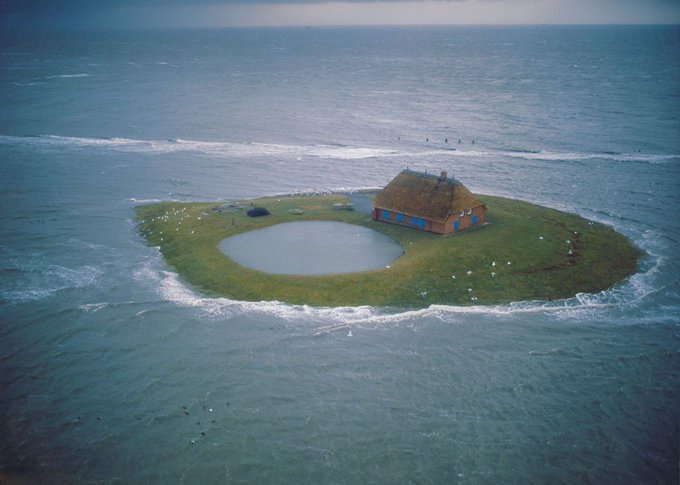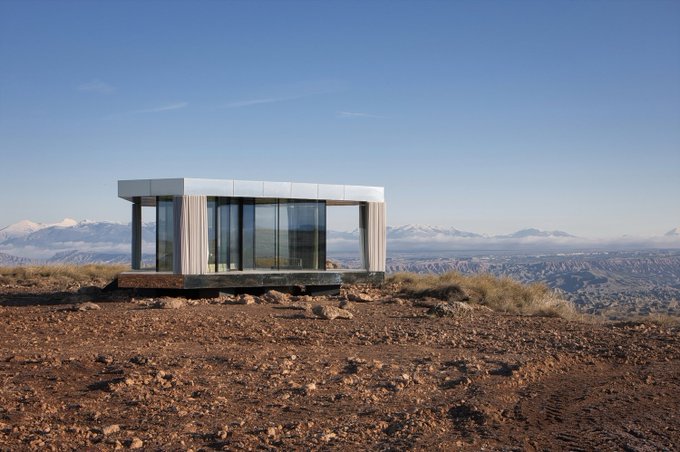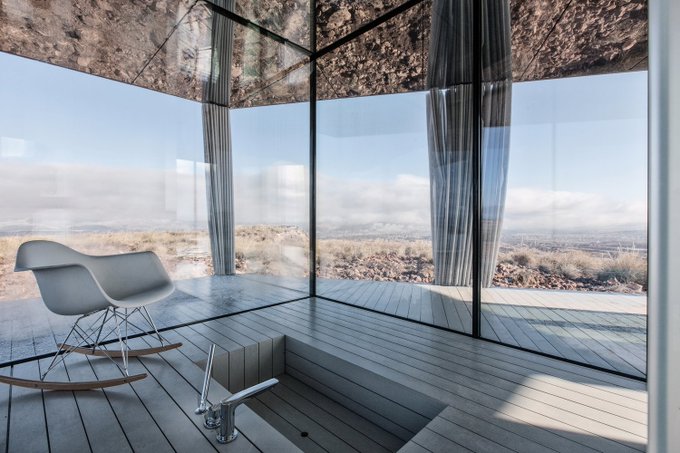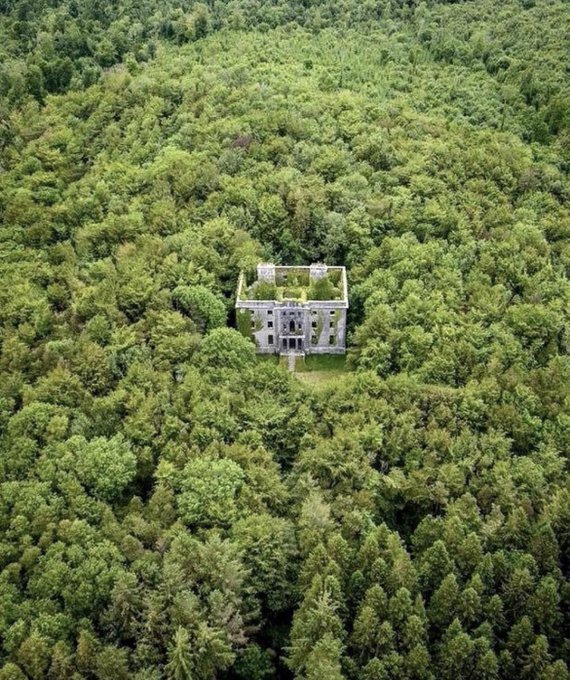Most Isolated Homes in the World

January 21, 2025
•17 min read
Let's delve into some of the most isolated homes in the world!
There’s too many people everywhere, and some of us have found it so crowded, they’ve removed themselves from the hustle and bustle entirely! From building lonesome mansions, mountainside huts, or one-house-islands, let's explore some of the most isolated homes in the world!
Thridrangaviti Lighthouse
Imagine being stationed alone for weeks on end, hearing nothing but the waves crashing around you. That’s the reality for a lot of lighthouse keepers. But if you thought living on a lighthouse out on the coast was isolating, you haven’t seen anything yet.
The Thridrangaviti Lighthouse isn’t found on the coast, it’s actually located on an isolated rock pillar, nearly 5 miles off the coast of southern Iceland. Built back in 1938, workers had the unenviable job of scaling the slippery rocks through rainstorms and winds, before reaching the pillar’s pinnacle and laying out the groundwork by hand.But if you thought building it was nightmare-inducing, imagine having to stay at that lighthouse. You’re perched on a pillar 120 feet up above the crashing waves of the freezing Atlantic Ocean! And you can’t exactly call for help. Firstly, who’s getting phone signal in the middle of the ocean? And, secondly, it’s going to take them a while to even reach you!Thankfully, the lighthouse was automated shortly after its creation, meaning no keeper had the terrifying task of staying at that remote home. Nowadays, with the invention of helicopters, a helipad has been constructed on top of the pillar, giving easier access to the lighthouse. Even still, any house you’ve got to ride a helicopter to reach has to go down as pretty isolated!Elliðaey Island: Loneliest House In The World
Apparently Iceland has something of a thing for remote homes, because just 10 miles east of the Thridrangaviti Lighthouse is another particularly private property. Elliðaey is a small remote island around 5 miles off the coast of southern Iceland.
Just Enough Room Island
Names tell us a lot about a place, perhaps none more so than Just Enough Room Island, one of the 1,800 islands dotting the St. Lawrence River off the coast of Alexandria Bay in New York. As the name aptly suggests, there really are not a lot of space there.
So, just how small is it? Well, at just 3,300 square-feet, it’s only slightly larger than a tennis court! There’s only enough space there to hold a tree, some shrubs, a small beach, and a house! While a tiny island doesn’t sound like the most suitable home, it was purchased in the 1950s by the Sizeland family.The idea was to use the plot of land to build their own secluded holiday-home. In fact, so precariously placed is the house on Just Enough Room Island, that rising tides quickly cause it to flood. So, sandbags are virtually part of the furnishings there!While that section of the St. Lawrence River stretches to a width close to 3 miles, the inhabitants of Just Enough Room Island do surprisingly have neighbors. One of the St. Lawrence’s 1,800 islands, includes the nearby inhabited Imperial Isle, found 250 feet down the river.Drina River House
Strange as it may sound, Just Enough Room Island isn’t the only precariously place property found on water. The Drina is a 215 mile-long river that runs through both Bosnia and Herzegovina, and Serbia. Yet, the most mind-blowing aspect of that waterway is what you’ll find poking out the water midway through its route.
That is the Drina River House. Though the town of Bajina Basta is less than a mile away, anyone that wants to pay that hut a visit has got the terrifying task of swimming through the terrifying 400-foot wide section of the river. Considering that’s over double the length of an Olympic-sized swimming pool, anyone willing to check out that shack better be comfortable in the water!
Desolation Peak
While swimming through rapid waters to reach the Drina River House is no easy feat, it’s more pleasant than what anyone visiting Desolation Peak has to endure. As the name suggests, that place is pretty isolated. In all, that hut is found at a head-spinning 6,100 feet above sea level! For context, that’s over twice the height of the Burj Khalifa!
Anyone wanting to reach that high hut is going to have to hike for a back-breaking 4 hours. On top of that, Desolation Peak is completely surrounded by natural landscape, meaning the nearest town is some 40 miles away. Even the nearest road is around 15 miles away from that place.Considering how remote that place is, you’d probably want to stay for a night to soak up the views, before heading back to civilization. However, that wasn’t possible for anyone who called Desolation Peak home. That hut found in the North Cascade Mountains of Washington, was built in 1932 by the United States Forest Service as a fire lookout.Typically, a single man would head up to Desolation Peak in July and be stationed there until September. That’s right, someone would be stationed there for months, with nothing but their own voice to keep them company! Hopefully, anyone assigned the fire lookout post at Desolation Peak brings plenty of snacks with them, because taking a trip to the local shop is not going to be too pretty!Hallig Habel
Just off the coast of northwest Germany, in the North Sea, sit 10 extremely low-lying islets, known as the Hallig Islands. Those Islands are so sunken, some of them flood up to 50 times a year! Yet, despite the risk of being swept out to sea, many of the Hallig Islands are populated.
Hallig Home in Northern Germany theshelterblog.com/hallig-home-no…
Deserted House
The aptly named Desert House is found in the unforgiving Gorafe desert, in northern Spain. Clearly a desert, with its hot, arid conditions don’t tend to be the best places to build a house. And the Gorafe desert is no different. With deep dropping gorges, sweltering 100F heat, and of course, a distinct lack of water, even Bear Grylls would find it a struggle living there!
La Casa del Desierto officially opened this week. Situated in #Spain ’s #Gorafe desert, one of the most extreme environments in Europe, this sustainable home challenges the norm with its use of glass! @OFIS_architects @guardianglasseu #SustainableArchitecture
The Hermitage Of San Colombano
Found in the Italian commune of Trambileno, you’d be forgiven for missing the Hermitage of San Colombano completely. If you didn’t know, a hermitage is a place where religious figures retreat to escape the busyness of everyday life, allowing them to focus more closely on their faith. And, it’s fair to say the Hermitage of San Colombano is certainly a remote retreat, set at a dizzying 400 feet up a cliff-face!
Amazingly, that hovel reaches a similar elevated height to the Great Pyramid of Giza! Despite the climb, it’s believed a religious hermit lived in the cliff’s caves in the 8th century, while construction of the church likely dates back to the 10th century. Though it’s no longer an active hermitage, that holy house still has its church, as well as various fascinating frescoes on the wall.But if you want to take a look for yourself, you better be prepared for an arduous ascent. For starters, visitors have to scale a rocky path, before ascending up a mammoth 102-step staircase carved into the rock. My thighs are burning just thinking about that journey! Reaching that holy house certainly sounds like a painful pilgrimage!Foronon Del Buinz Mountain Hut
Traveling through 8 countries, stretching 750 miles-long, and reaching heights over 15,000 feet above sea level, the Alps are one of the highest and most extensive mountain ranges in Europe. Anyone trekking across that massive mountain range can expect to see alpine lakes, deep-dropping valleys and though not the tallest peak in the Alps, the Foronon del Buinz mountain ascends some 8,300 feet above sea level!
Yet, despite that heady height you can find this next property at its peak! Found at altitude around 8 times the height of the Eiffel Tower is the Foronon del Buinz Mountain Hut. The hut was commissioned by the family of the late mountain climber, Luca Vuerich, who tragically passed away in an avalanche nearby.Buffa Di Perrero
Just over 60 miles west of the Foronon del Buinz Mountain Hut is another high home. The Buffa di Perrero is found at a staggering 9,000 feet above sea level. Located on the Mount Cristallo of the Dolomite Mountains in Italy, that place is found at an elevation greater than the highest point on the rim of the Grand Canyon. It’s also embedded into the vertical rockface.
You are probably wondering what that secluded shelter is doing there? For years, people pondered on its purpose. Was it some secret hermit cave? Maybe a clue to a lost civilization of mountainside dwellers? In reality, that bizarre building, known as the Buffa di Perrero, is a remnant of the First World War!While you might think of trenches and muddy battlefields at the thought of World War One, that conflict also involved fighting between Italian and Austro-Hungarian troops in the Dolomite Mountains. It’s believed Italian soldiers somehow constructed that property as a means of shelter from the enemy and the conditions.Somehow, someway, Italian soldiers managed to climb the mountainside, all while carrying building materials to construct the Buffa di Perrero. And that’s not even mentioning the constant threat of the enemy shooting at them!
Aare Gorge
Surprisingly, Buffa di Perrero isn’t the only nature-hidden home. The Aare Gorge, found in the middle of Switzerland looks like the perfect place to unwind and be at one with nature. Clearly someone out there wants to be at one with nature every single day, as tucked in the cliffs of that 650-foot deep gorge is a mysterious entrance point, revealing a hidden home inside the gorge. In fact, there are two entrances bored into the rock.
Solvay Hut
The Matterhorn is one of the Alps largest and most daunting mountains. In all, that massive mountain, straddling between Italy and Switzerland, has a summit over 14,500 feet above sea level. For reference, that’s not far off the height of the Foronon del Buinz Hut and the Buffa di Perrero stacked on top of each other!
Anyone with a fear of heights will be glad to know there’s no shack at the Matterhorn’s summit. There is however, one hidden hut found near the mountain’s peak. At a breathtaking elevation of over 13,000 feet, the Solvay Hut is quite the mission to get to!If you were wondering how high 13,000 feet is, it’d take around 30 seconds for someone falling from such a height to hit the ground! Constructed in 1915, building materials were first carried up by donkeys to an elevation around 10,000 feet. From there a small cable car was used to transport the materials up to the 13,000 foot-high building site.Moore Hall
It’s most people’s dream in life to have their own grand mansion that they can call home. Presumably, that was also the case with George Moore. He was a wealthy man, who made his fortune as a wine and brandy merchant during the 18th century. With his fortune he thought it’d be a good idea to splash the cash on a mega house.
So, in 1792, he had Moore Hall built in Mayo, Ireland. Long after George Moore passed, his descendants continued to live in the massive mansion. That was until 1923, when, during the Irish Civil War, Moore Hall was burnt down by the Irish Republican Army due to the then-owner Maurice Moore’s loyalty to Britain.
Moorehall, a house and estate built in 1795 in Mayo, Ireland, was tragically burnt down in 1923 during the Irish Civil War and has remained abandoned since. The history of Moore Hall is rich, with tales dating back as far as 400 AD. The Moores, an aristocratic Irish family, were
LilliHaus Floating House
While anyone unlucky enough to stay at Moore House will be greeted by a sight of trees, trees, and more trees outside the window, anyone residing at the LilliHaus has a slightly different view. Anyone looking out the window of that house will have a whole lot of water staring back at them.
Katskhi Pillar Monastery
The landscape near the village of Katshki in Georgia is dominated by rolling hills and lush green trees. That is, until you come across the site in the image below. Alien as it looks, that is a natural limestone monolith that towers 130 feet above the surrounding landscape. But even more jaw-dropping than the mega monolith, is what you’ll find on top of it.
With the arrival of Christianity to the region around the 4th century, the towering rock became a place of seclusion for stylites. They were a group of early Christians who became obsessed with preaching, fasting, praying and living on pillars. Between the 6th and 9th century they miraculously managed to build two churches atop of the pillar. Sadly for them, by the 15th century, the Islamic Ottoman Empire’s rule ended the puzzling practice, leaving the pillar uninhabited for centuries.It wasn’t until the 1990s, when a local monk by the name of Father Maxim Qavtaradze built a new monastery. Building a monastery after climbing a 130 foot-tall pillar? Sounds like only a feat spiderman’s capable of. Turns out Father Qavtaradze ingeniously constructed a 130-foot long iron ladder along the pillar, helping him scale the column.

























